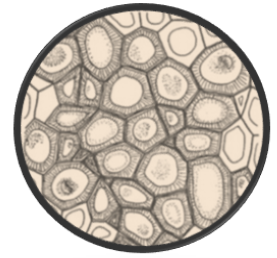
The tissue which has dead cells in the functional state is
(a) Collenchyma
(b) Sclerenchyma
(c) Parenchyma
(d) Phloem
Answer
489.3k+ views
Hint: These cells provide rigidity, mechanical support, support transportation of water, and nutrients to the plants.
Complete step-by-step answer:

Sclerenchyma has a very thick cell wall due to the deposition of lignin and cells are dead cells at maturity. They are located in the leaf veins, hard coverings of the seeds, and also found surrounding the vascular bundle. They are present in the form of fibers or sclereids (stone cells) and other functions include plant stiffness and hardness.
Additional Information:
-Parenchyma- these are living tissues with a thin cell wall (made of cellulose) with dense cytoplasm and central vacuole. They are located in the parts such as the pith and cortex where the parts are soft. These cells store food, exchange gas, and help in photosynthesis. The parenchyma cells are diametric in shape.
-Collenchyma- these are living tissues having an elongated shape and thick cell wall (made of cellulose, pectin, and hemicellulose) in the corner. The cell walls are uneven in shape. They can be located in the leaf veins, stem, and below the epidermis, etc. collenchyma cells provide mechanical support and elasticity to the plant allowing for easy bending without breakage.
-Phloem- it transports the soluble organic compounds made during photosynthesis to sink tissues (ex. non-photosynthetic root cells or developing flowers) and the process is known as photosynthates and is a living tissue in vascular plants.
So, the correct answer is 'Sclerenchyma'.
Note: A class of complex organic polymers that form structural materials in the support tissues of vascular plants and some algae is known as lignin. It is abundant in cell walls of some specific cells and its functions are water transport, mechanical support, and resistance to various stresses.
Complete step-by-step answer:

Figure: Structure of sclerenchyma
Sclerenchyma has a very thick cell wall due to the deposition of lignin and cells are dead cells at maturity. They are located in the leaf veins, hard coverings of the seeds, and also found surrounding the vascular bundle. They are present in the form of fibers or sclereids (stone cells) and other functions include plant stiffness and hardness.
Additional Information:
-Parenchyma- these are living tissues with a thin cell wall (made of cellulose) with dense cytoplasm and central vacuole. They are located in the parts such as the pith and cortex where the parts are soft. These cells store food, exchange gas, and help in photosynthesis. The parenchyma cells are diametric in shape.
-Collenchyma- these are living tissues having an elongated shape and thick cell wall (made of cellulose, pectin, and hemicellulose) in the corner. The cell walls are uneven in shape. They can be located in the leaf veins, stem, and below the epidermis, etc. collenchyma cells provide mechanical support and elasticity to the plant allowing for easy bending without breakage.
-Phloem- it transports the soluble organic compounds made during photosynthesis to sink tissues (ex. non-photosynthetic root cells or developing flowers) and the process is known as photosynthates and is a living tissue in vascular plants.
So, the correct answer is 'Sclerenchyma'.
Note: A class of complex organic polymers that form structural materials in the support tissues of vascular plants and some algae is known as lignin. It is abundant in cell walls of some specific cells and its functions are water transport, mechanical support, and resistance to various stresses.
Recently Updated Pages
Master Class 11 Economics: Engaging Questions & Answers for Success

Master Class 11 Business Studies: Engaging Questions & Answers for Success

Master Class 11 Accountancy: Engaging Questions & Answers for Success

The correct geometry and hybridization for XeF4 are class 11 chemistry CBSE

Water softening by Clarks process uses ACalcium bicarbonate class 11 chemistry CBSE

With reference to graphite and diamond which of the class 11 chemistry CBSE

Trending doubts
10 examples of friction in our daily life

One Metric ton is equal to kg A 10000 B 1000 C 100 class 11 physics CBSE

Difference Between Prokaryotic Cells and Eukaryotic Cells

State and prove Bernoullis theorem class 11 physics CBSE

What organs are located on the left side of your body class 11 biology CBSE

How many valence electrons does nitrogen have class 11 chemistry CBSE




